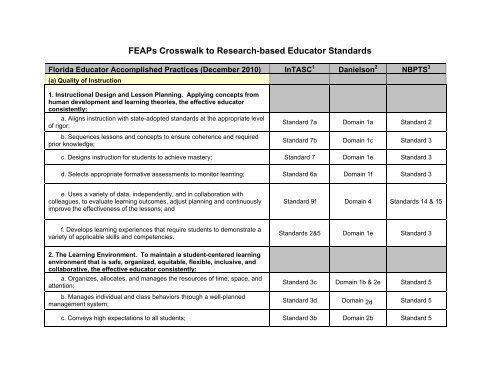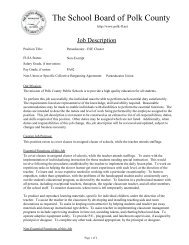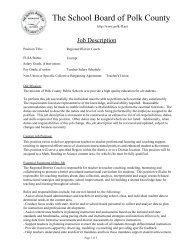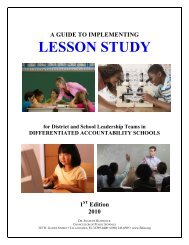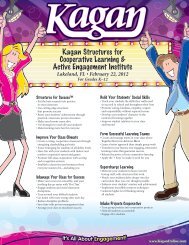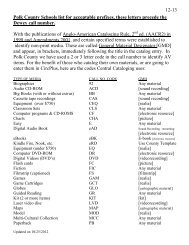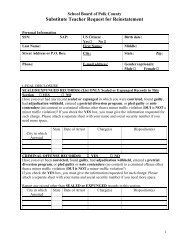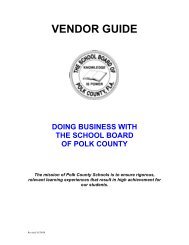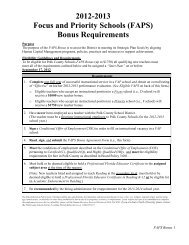FEAPs Crosswalk to Research-based Educator Standards
FEAPs Crosswalk to Research-based Educator Standards
FEAPs Crosswalk to Research-based Educator Standards
Create successful ePaper yourself
Turn your PDF publications into a flip-book with our unique Google optimized e-Paper software.
<strong>FEAPs</strong> <strong>Crosswalk</strong> <strong>to</strong> <strong>Research</strong>-<strong>based</strong> Educa<strong>to</strong>r <strong>Standards</strong><br />
Florida Educa<strong>to</strong>r Accomplished Practices (December 2010) InTASC 1 Danielson 2 NBPTS 3<br />
(a) Quality of Instruction<br />
1. Instructional Design and Lesson Planning. Applying concepts from<br />
human development and learning theories, the effective educa<strong>to</strong>r<br />
consistently:<br />
a. Aligns instruction with state-adopted standards at the appropriate level<br />
of rigor;<br />
b. Sequences lessons and concepts <strong>to</strong> ensure coherence and required<br />
prior knowledge;<br />
Standard 7a Domain 1a Standard 2<br />
Standard 7b Domain 1c Standard 3<br />
c. Designs instruction for students <strong>to</strong> achieve mastery; Standard 7 Domain 1e Standard 3<br />
d. Selects appropriate formative assessments <strong>to</strong> moni<strong>to</strong>r learning; Standard 6a Domain 1f Standard 3<br />
e. Uses a variety of data, independently, and in collaboration with<br />
colleagues, <strong>to</strong> evaluate learning outcomes, adjust planning and continuously<br />
improve the effectiveness of the lessons; and<br />
Standard 9f Domain 4 <strong>Standards</strong> 14 & 15<br />
f. Develops learning experiences that require students <strong>to</strong> demonstrate a<br />
variety of applicable skills and competencies.<br />
<strong>Standards</strong> 2&5 Domain 1e Standard 3<br />
2. The Learning Environment. To maintain a student-centered learning<br />
environment that is safe, organized, equitable, flexible, inclusive, and<br />
collaborative, the effective educa<strong>to</strong>r consistently:<br />
a. Organizes, allocates, and manages the resources of time, space, and<br />
attention;<br />
b. Manages individual and class behaviors through a well-planned<br />
management system;<br />
Standard 3c Domain 1b & 2e Standard 5<br />
Standard 3d Domain 2d Standard 5<br />
c. Conveys high expectations <strong>to</strong> all students; Standard 3b Domain 2b Standard 5
Florida Educa<strong>to</strong>r Accomplished Practices (December 2010)<br />
InTASC 1 Danielson 2 NBPTS 3<br />
d. Respects students’ cultural, linguistic and family background; Standard 2d Domains 2a & 2b Standard 5<br />
e. Models clear, acceptable oral and written communication skills; Standard 8h Domain 3a Standard 2<br />
f. Maintains a climate of openness, inquiry, fairness and support; Standard 3b Domain 2b & 2a Standard 4<br />
g. Integrates current information and communication technologies; standard 8h Standard 6<br />
h. Adapts the learning environment <strong>to</strong> accommodate the differing needs<br />
and diversity of students; and<br />
i. Utilizes current and emerging assistive technologies that enable<br />
students <strong>to</strong> participate in high-quality communication interactions and achieve<br />
their educational goals.<br />
Standard 3e Domain 1b & 2 Standard 5<br />
Standard 8 Standard 6<br />
3. Instructional Delivery and Facilitation. The effective educa<strong>to</strong>r<br />
consistently utilizes a deep and comprehensive knowledge of the<br />
subject taught <strong>to</strong>:<br />
a. Deliver engaging and challenging lessons; Standard 8 Domain 3<br />
b. Deepen and enrich students’ understanding through content area<br />
literacy strategies, verbalization of thought, and application of the subject<br />
matter;<br />
Standard 5 Domain 3<br />
c. Identify gaps in students’ subject matter knowledge; Standard 6 Domain 3<br />
d. Modify instruction <strong>to</strong> respond <strong>to</strong> preconceptions or misconceptions; Standard 8 Domain 3<br />
e. Relate and integrate the subject matter with other disciplines and life<br />
experiences;<br />
Standard 5 Domain 1, 2, 3<br />
f. Employ higher-order questioning techniques; Standard 8 Domain 3b<br />
NBPTS/subject<br />
specific<br />
NBPTS/subject<br />
specific<br />
NBPTS/subject<br />
specific<br />
NBPTS/subject<br />
specific<br />
NBPTS/subject<br />
specific<br />
NBPTS/subject<br />
specific
Florida Educa<strong>to</strong>r Accomplished Practices (December 2010) InTASC 1 Danielson 2 NBPTS 3<br />
g. Apply varied instructional strategies and resources, including<br />
appropriate technology, <strong>to</strong> provide comprehensible instruction, and <strong>to</strong> teach<br />
for student understanding;<br />
Standard 8<br />
Domain 1e<br />
NBPTS/subject<br />
specific<br />
h. Differentiate instruction <strong>based</strong> on an assessment of student learning<br />
needs and recognition of individual differences in students;<br />
Standard 8<br />
Domain 3d<br />
NBPTS/subject<br />
specific<br />
i. Support, encourage, and provide immediate and specific feedback <strong>to</strong><br />
students <strong>to</strong> promote student achievement; and<br />
Standard 8g<br />
Domain 3a<br />
NBPTS/subject<br />
specific<br />
j. Utilize student feedback <strong>to</strong> moni<strong>to</strong>r instructional needs and <strong>to</strong> adjust<br />
instruction.<br />
Standard 8b<br />
Domain 3e<br />
NBPTS/subject<br />
specific<br />
4. Assessment. The effective educa<strong>to</strong>r consistently:<br />
a. Analyzes and applies data from multiple assessments and measures<br />
<strong>to</strong> diagnose students’ learning needs, informs instruction <strong>based</strong> on those<br />
needs, and drives the learning process;<br />
Standard 6e Domain 3 Standard 13<br />
b. Designs and aligns formative and summative assessments that match<br />
learning objectives and lead <strong>to</strong> mastery;<br />
c. Uses a variety of assessment <strong>to</strong>ols <strong>to</strong> moni<strong>to</strong>r student progress,<br />
achievement and learning gains;<br />
d. Modifies assessments and testing conditions <strong>to</strong> accommodate learning<br />
styles and varying levels of knowledge;<br />
Standard 6a & 6b Domain 1f Standard 13<br />
Standard 6b Domain 1f & 3d Standard 13<br />
Standard 6f Domain 3e Standard 13<br />
e. Shares the importance and outcomes of student assessment data with<br />
the student and the student’s parent/caregiver(s);<br />
Standard 6f Domain 3d Standard 13<br />
f. Applies technology <strong>to</strong> organize and integrate assessment information. Standard 6g Standard 13
Florida Educa<strong>to</strong>r Accomplished Practices (December 2010) InTASC 1 Danielson 2 NBPTS 3<br />
(b) Continuous Improvement, Responsibility and Ethics<br />
1. Continuous Professional Improvement. The effective educa<strong>to</strong>r<br />
consistently:<br />
a. Designs purposeful professional goals <strong>to</strong> strengthen the effectiveness<br />
of instruction <strong>based</strong> on students’ needs;<br />
b. Examines and uses data-informed research <strong>to</strong> improve instruction and<br />
student achievement;<br />
Standard 9a Domain 4 <strong>Standards</strong> 14 & 15<br />
Standard 9f Domain 4 <strong>Standards</strong> 14 & 15<br />
c. Collaborates with the home, school and larger communities <strong>to</strong> foster<br />
communication and <strong>to</strong> support student learning and continuous improvement;<br />
Standard 10b &<br />
10c<br />
Domain 4 Standard 16<br />
d. Engages in targeted professional growth opportunities and reflective<br />
practices, and<br />
Standard 10c Domain 4 Standard 14 & 15<br />
e. Implements knowledge and skills learned in professional development<br />
in the teaching and learning process.<br />
Standard 9f, 10c &<br />
10d<br />
Domain 4 (weak) Standard 14 & 15<br />
2. Professional Responsibility and Ethical Conduct. Understanding that<br />
educa<strong>to</strong>rs are held <strong>to</strong> a high moral standard in a community, the<br />
effective educa<strong>to</strong>r adheres <strong>to</strong> the Code of Ethics and the Principles of<br />
Professional Conduct of the Education Profession of Florida, pursuant<br />
<strong>to</strong> State Board of Education Rules 6B-1.001 and 6B-1.006, F.A.C., and<br />
fulfills the expected obligations <strong>to</strong> students, the public and the<br />
education profession.<br />
Domain 4f<br />
1<br />
Council of Chief State School Officers. (2010, July). Interstate Teacher Assessment and Support Consortium (InTASC)<br />
Model Core Teaching <strong>Standards</strong>: A Resource for State Dialogue (Draft for Public Comment). Washing<strong>to</strong>n, DC: Author.<br />
(http://www.ccsso.org/Resources/Publications/Model_Core_Teaching_<strong>Standards</strong>.html)<br />
2 Charlotte Danielson, Enhancing Professional Practice: A Framework for Teaching (Virginia: ASCD, 2007).<br />
3 National Board for Professional Teaching <strong>Standards</strong>. http://www.nbpts.org/the_standards


